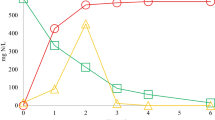Abstract
The biphenyl-degrading strain, Pseudomonas sp. KM-04, was isolated from polychlorinated biphenyls-contaminated soil sample obtained from the vicinity of a former coal mine. We herein report that strain KM-04 can use biphenyl as a sole carbon source, and resting cells convert biphenyl to its corresponding metabolic intermediates. Incubation of KM-04 with autoclaved mining-contaminated soil for 10 days in a slurry system reduced the levels of biphenyl and 2-chlorobiphenyl by 98.5 % and 82.3 %, respectively. Furthermore, treatment of a mine-soil microcosm with strain KM-04 for 15 days in a composting system under laboratory conditions reduced the levels of biphenyl and 2-chlorobiphenyl by 87.1 % and 68.7 %, respectively. These results suggest that KM-04 is a potential candidate for the biological removal of biphenyl and its chlorinated derivatives from polychlorinated biphenyl-contaminated mining areas.



Similar content being viewed by others
References
Bench DW (2010) Identification, management and disposal of PCB-containing equipment used in mines. In: The Organizing Committee of the 14th International Conference on Tailings and Mine Waste (Ed.), Tailings and mine waste pp. 275–283. London: CRC Press
Bhuiyan MA, Islam MA, Dampare SB, Parvez L, Suzuki S (2010) Evaluation of hazardous metal pollution in irrigation and drinking water systems in the vicinity of a coal mine area of northwestern Bangladesh. J Hazard Mater 179:1065–1077
Catelani D, Colombi A, Sorlini C, Treccani V (1973) Metabolism of biphenyl. 2-Hydroxy-6-oxo-6-phenylhexa-2,4-dienoate: the meta-cleavage product from 2,3-dihydroxybiphenyl by Pseudomonas putida. Biochem J 134:1063–1066
D’Angelo E, Nunez A (2010) Effect of environmental conditions on polychlorinated biphenyl transformations and bacterial communities in a river sediment. J Soils Sediments 10:1186–1199
Dulfer WJ, Govers HAJ (1995) Membrane-water partitioning of polychlorinated biphenyls in small unilamellar vesicles of four saturated phosphatidylcholines. Environ Sci Technol 29:2548–2554
EPA (1996) Test methods for evaluating solid wastes, EPA Method SW 846. United States Government Printing Office, Washington DC
Erickson BD, Mondello FJ (1992) Nucleotide sequencing and transcriptional mapping of the genes encoding biphenyl dioxygenase, a multicomponent polychlorinated-biphenyl-degrading enzyme in Pseudomonas strain LB400. J Bacteriol 174:2903–2912
Furukawa K, Suenaga H, Goto M (2004) Biphenyl dioxygenases: functional versatilities and directed evolution. J Bacteriol 186:5189–5196
Hayase N, Taira K, Furukawa K (1990) Pseudomonas putida KF715 bphABCD operon encoding biphenyl and polychlorinated biphenyl degradation: cloning analysis, and expression in soil bacteria. J Bacteriol 172:1160–1164
Heuer H, Krsek M, Baker P, Smalla K, Wellington EM (1997) Analysis of actinomycete communities by specific amplification of genes encoding 16S rRNA and gel-electrophoretic separation in denaturing gradients. Appl Environ Microbiol 63:3233–3241
Kikuchi Y, Yasukochi Y, Nagata Y, Fukuda M, Takagi M (1994) Nucleotide sequence and functional analysis of the meta-cleavage pathway involved in biphenyl and polychlorinated biphenyl degradation in Pseudomonas sp. strain KKS102. J Bacteriol 176:4269–4276
Kimbara K, Hashimoto T, Fukuda M, Koana T, Takagi M, Oishi M, Yano K (1989) Cloning and sequencing of two tandem genes involved in degradation of 2,3-dihydroxybiphenyl to benzoic acid in the polychlorinated biphenyl-degrading soil bacterium Pseudomonas sp. strain KKS102. J Bacteriol 171:2740–2747
Li A, Qu Y, Zhou J, Gou M (2009) Isolation and characteristics of a novel biphenyl-degrading bacterial strain, Dyella ginsengisoli LA-4. J Environ Sci 21:211–217
Masai E, Yamada A, Healy JM, Hatta T, Kimbara K, Fukuda M, Yano K (1995) Characterization of biphenyl catabolic genes of gram-positive polychlorinated biphenyl degrader Rhodococcus sp. strain RHA1. Appl Environ Microbiol 61:2079–2085
Nam IH, Hong HB, Kim YM, Kim BH, Murugesan K, Chang YS (2005) Biological removal of polychlorinated dibenzo-p-dioxins from incinerator fly ash by Sphingomonas wittichii RW1. Water Res 39:4651–4660
Nam IH, Kim YM, Schmidt S, Chang YS (2006) Biotransformation of 1,2,3-tri- and 1,2,3,4,7,8-hexachlorodibenzo-p-dioxin by Sphingomonas wittichii strain RW1. Appl Environ Microbiol 72:112–116
Petric I, Hrsak D, Fingler S, Udikovic-Kolic N, Bru D, Martin-Laurent F (2011) Insight in the PCB-degrading functional community in long-term contaminated soil under bioremediation. J Soils Sediments 11:290–300
Pieper DH (2005) Aerobic degradation of polychlorinated biphenyls. Appl Microbiol Biotechnol 67:170–191
Safe S (1990) Polychlorinated biphenyls (PCBs), dibenzo-p-dioxins (PCDDs), dibenzofurans (PCDFs), and related compounds: environmental and mechanistic considerations which support the development of toxic equivalency factors (TEFs). Crit Rev Toxicol 21:51–88
Shuai JJ, Tian YS, Yao QH, Peng RH, Xiong F, Xiong AS (2010) Identification and analysis of polychlorinated biphenyls (PCBs)-biodegrading bacterial strains in Shanghai. Curr Microbiol 61:477–483
Taguchi K, Motoyama M, Iida T, Kudo T (2007) Polychlorinated biphenyl/biphenyl degrading gene clusters in Rhodococcus sp. K37, HA99, and TA431 are different from well-known bph gene clusters of Rhodococci. Biosci Biotechnol Biochem 71:1136–1144
Tsezos M, Bell JP (1989) Comparison of the biosorption and desorption of hazardous organic pollutants by live and dead biomass. Water Res 23:561–568
Van Birgelen APJM, DeVito MJ, Akins JM, Ross DG, Diliberto JJ, Birnbaum LS (1996) Relative potencies of polychlorinated dibenzo-p-dioxins, dibenzofurans, and biphenyls derived from hepatic porphyrin accumulation in mice. Toxicol Appl Pharmacol 138:98–109
Yang X, Liu X, Song L, Xie F, Zhang G, Qian S (2007) Characterization and functional analysis of a novel gene cluster involved in biphenyl degradation in Rhodococcus sp. strain R04. J Appl Microbiol 103:2214–2224
Acknowledgments
This work was supported by the KIGAM (Korean Institute of Geosciences and Mineral Resources) research fund (Project No. 3212 and 7621).
Author information
Authors and Affiliations
Corresponding author
Rights and permissions
About this article
Cite this article
Nam, IH., Chon, CM., Jung, KY. et al. Biodegradation of Biphenyl and 2-Chlorobiphenyl by a Pseudomonas sp. KM-04 Isolated from PCBs-Contaminated Coal Mine Soil. Bull Environ Contam Toxicol 93, 89–94 (2014). https://doi.org/10.1007/s00128-014-1286-6
Received:
Accepted:
Published:
Issue Date:
DOI: https://doi.org/10.1007/s00128-014-1286-6




